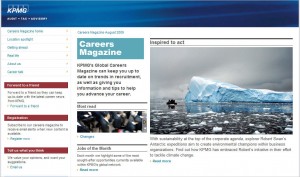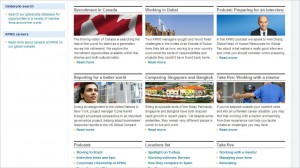KPMG–a “mature” company that has reinvented its employer image with admirable panache–won the 2008 ERE award for Best Corporate Careers Site. One of the practices they received praise for: “Weekly Web design and content refresh meetings ensure that the site content is always fresh.”
So I thought it would be interesting to see how things are going there a year later. The main Careers site looks nice enough—though it seems a little overstuffed. But actually I didn’t spend much time there, because a link labeled “Global careers magazine” caught my eye. Several of my recent posts have addressed aspects of global recruiting, and there will be more, so I zipped over for a look.
And I loved the top page (which illustrates this post) right away. The dramatic iceberg image captures attention for a strong message: “Inspired to act.” Focusing on sustainability as a corporate priority sets a great tone.
Scroll down, and there’s a rich array of content:
I was just about to enthuse about this excellent example of corporate communication when I noticed the line “Careers Magazine August 2009.” I’m writing this at the beginning of October, so there’s a definite freshness gap. Also—a promise broken. Either it’s a monthly magazine, or it’s not. (If it’s meant to be a bi-monthly magazine, the dateline should really say August/September; and besides, the section right below it is headed “Jobs of the Month”.)
Maybe there’s a more current issue that goes to subscribers? I’ve joined the subscription list, and will update if/when something new appears. But I have to report in the meantime that registering to receive this publication was not a positive experience. The registration process itself was okay, but in order to sign up for the Global Careers Magazine I had to sleuth through a list of 25 (yes, really) publications, such as “Audit committee insights” and “Chemical issues monitor.” Although the available items cover a range of types (magazines, e-updates, newsletters) and focus on a wide variety of industries, they are arranged alphabetically instead of being grouped by some sort of helpful logic.
These may seem like small items, and it’s unlikely that an out-of-date online magazine and an unwieldy subscription list will offend or even annoy most visitors. But details like these leave an impression. Did no one have time to publish a September issue of the magazine? Why not? Are they all overworked, has staff been cut back, has global hiring been put on hold? I think these questions might cross many minds.
And the thing is . . . KPMG didn’t even actually have to publish a new magazine! They could just have removed the word “August” from the page, and that would have fixed the problem, at least for most visitors. Which makes me even more convinced that no one at the company is taking ownership.
So this is basically another opportunity to remark on the importance of (a) paying attention to the state of the website—and (b) watching out for those subtle, unintentional messages that can creep in while everyone is busy with something else.
Cynthia Giles has followed a serpentine career path from academia to publishing to marketing and design to information technology and corporate communications. There’s plenty of detail about this journey at www.cynthiagiles.com, but briefly--the common theme has been ideas, and how to present them effectively. Along the way, she became an accidental expert on data warehousing and business intelligence, and for the past ten years she has combined corporate contracting with an independent consulting practice that focuses on marketing strategy for smaller businesses and non-profits.
Having spent quite a bit of time looking for work, and anywhere from two weeks to two years inside a wide variety of American companies—she has given much thought to what works (and what doesn’t) when it comes to creating a great employment fit.

